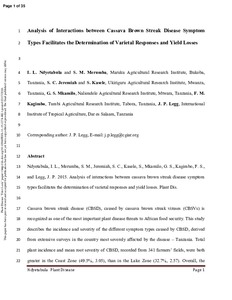| dc.contributor.author | Ndyetabula, I.L. |
| dc.contributor.author | Merumba, S.M. |
| dc.contributor.author | Jeremiah, S.C. |
| dc.contributor.author | Kasele, S. |
| dc.contributor.author | Mkamilo, G.S. |
| dc.contributor.author | Kagimbo, F.M. |
| dc.contributor.author | Legg, J.P. |
| dc.date.accessioned | 2019-12-04T11:04:03Z |
| dc.date.available | 2019-12-04T11:04:03Z |
| dc.date.issued | 2016-07 |
| dc.identifier.citation | Ndyetabula, I.L., Merumba, S.M., Jeremiah, S.C., Kasele, S., Mkamilo, G.S., Kagimbo, F.M. & Legg, J. (2016). Analysis of interactions between cassava brown streak disease symptom types facilitates the determination of varietal responses and yield losses. Plant Disease, 100(7), 1388-1396. |
| dc.identifier.issn | 0191-2917 |
| dc.identifier.uri | https://hdl.handle.net/20.500.12478/1326 |
| dc.description.abstract | Cassava brown streak disease (CBSD), caused by cassava brown streak viruses, is recognized as one of the most important plant disease threats to African food security. This study describes the incidence and severity of the different symptom types caused by CBSD, derived from extensive surveys in the country most severely affected by the disease: Tanzania. Total plant incidence and mean root severity of CBSD, recorded from 341 farmers’ fields, were both greater in the Coast Zone (49.5% and 3.05), than in the Lake Zone (32.7% and 2.57). Overall, the differing incidences recorded declined in the following order: total plant incidence (39.1%), plant shoot incidence (33.4%), plant root incidence (19.3%), root incidence (10.5%), and unusable root incidence (5.4%). The much lower-than-anticipated loss due to the root necrosis that is characteristic of CBSD was offset by large reductions of root number in plants expressing foliar symptoms of CBSD (15.7% in the Coast Zone and 5.5% in the Lake Zone). These data suggest that the effects of CBSD on the growth of affected plants are greater than those due to root spoilage. Based on these two factors, annual losses due to CBSD in the parts of Tanzania surveyed were estimated at >860,000 t, equivalent to more than U.S.$51 million. A novel approach to using farm-derived data on the responses of the most frequently cultivated varieties to CBSD infection allowed the grouping of the varieties into four categories, based on their relative resistance or tolerance to infection. This tool should be of value to breeders in identifying and selecting for sources of resistance or tolerance in both local and exotic germplasm, and should ultimately contribute to enhancing the management of one of Africa’s most damaging crop diseases. |
| dc.format.extent | 1388-1396 |
| dc.language.iso | en |
| dc.subject | African Cassava Mosaic Virus |
| dc.subject | Crop Losses |
| dc.subject | Disease Resistance |
| dc.subject | Necrosis |
| dc.subject | Disease Tolerance |
| dc.title | Analysis of interactions between cassava brown streak disease symptom types facilitates the determination of varietal responses and yield losses |
| dc.type | Journal Article |
| dc.description.version | Peer Review |
| cg.contributor.crp | Roots, Tubers and Bananas |
| cg.contributor.affiliation | Maruku Agricultural Research Institute, Tanzania |
| cg.contributor.affiliation | Ukiriguru Agricultural Research Institute, Tanzania |
| cg.contributor.affiliation | Naliendele Agricultural Research Institute, Tanzania |
| cg.contributor.affiliation | Tumbi Agricultural Research Institute |
| cg.contributor.affiliation | International Institute of Tropical Agriculture |
| cg.coverage.region | Africa |
| cg.coverage.region | East Africa |
| cg.coverage.country | Tanzania |
| cg.isijournal | ISI Journal |
| cg.authorship.types | CGIAR and developing country institute |
| cg.iitasubject | Cassava |
| cg.iitasubject | Plant Diseases |
| cg.journal | Plant Disease |
| cg.howpublished | Formally Published |
| cg.accessibilitystatus | Limited Access |
| local.dspaceid | 79148 |
| cg.targetaudience | Scientists |
| cg.identifier.doi | https://dx.doi.org/10.1094/PDIS-11-15-1274-RE |

